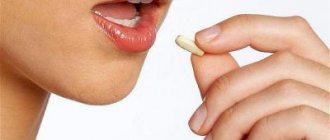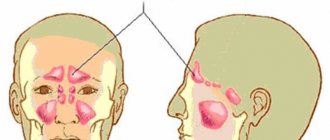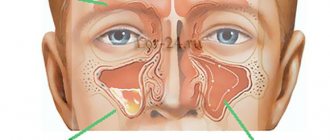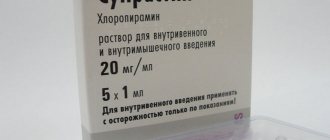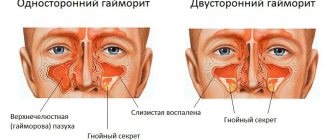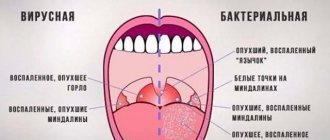Some diagnoses have a fairly simple name, making them easy for people to understand. Therefore, the patient will naturally have a question when he sees the word “polysinusitis” in the chart or extract - what is it? And what is incomprehensible immediately brings to mind a terrible and incurable disease. Although this disease is not considered mild, its timely detection and treatment can completely eliminate the existing risks.
So what is polysinusitis? In otorhinolaryngological practice, a similar term refers to an inflammatory process localized in two or more paranasal sinuses. Moreover, the lesion can be both acute and chronic, which in some cases complicates the clinical diagnosis of the disease. Moreover, both forms are equally fraught with the development of complications, so the doctor must be equally well aware of the signs of polysinusitis in certain variants of the course.
The treatment of the disease is divided according to the same principle - each type requires a specific and individual approach. Acute polysinusitis, for example, is mostly treated conservatively - with the help of a complex of antibacterial and anti-inflammatory drugs. But the chronic form may require radical surgical intervention, without which a complete cure will not be possible.
Polysinusitis, what is it?
Humans have 7 paranasal sinuses:
- Two maxillary sinuses, which are located in the maxillary bone (on the side of the nose and under the eyes).
- Two frontal or frontal, located in the frontal bone behind the brow ridges.
- Two sinuses called the ethmoid labyrinth. They are located between the pubic and maxillary sinuses, close to the eye orbits.
- Sphenoid or sphenoid (in the thickness of the sphenoid bone).
When two different types of sinuses become inflamed, polysinusitis occurs. The word sinusitis comes from Lat. sinus, which means sinus. The sinuses are cavities connected to the nasal cavity through the anastomosis. During breathing, air enters them for further purification and warming.
Interesting fact: the most common combination is sinusitis and ethmoiditis.
Sinusitis is characterized by swelling of the mucous membrane lining the sinuses. Normally, it produces a small amount of mucus, but during illness there is hypersecretion. Since the sinus anastomosis is blocked due to swelling, the mucus has nowhere to go, and it accumulates inside the sinus. This causes discomfort and creates additional conditions for the proliferation of microbes. In the future, suppuration and infection of surrounding tissues are possible.
Weak immunity, as well as underdevelopment of the facial bones in children, determines the incidence of polysinusitis. In babies, the bones have not yet fully grown, the space in the sinuses is limited, and the anastomosis between the nose is very thin. Therefore, at this age, the likelihood of inflammation spreading from one sinus to another is much higher. In addition, the disease is more severe and complications occur more often.
Classification and types of disease
There are different types of sinusitis, differing in the localization of the pathological process, the course of the disease, and the causes of the disease. Despite the fact that the classification of pathological processes in the paranasal sinuses is quite extensive, the symptoms of various sinusitis are very similar.
Depending on the etiological factor, the following classification of sinusitis is accepted:
- Traumatic (formed as a result of injuries to the nose)
- Viral (developing after a virulent infection)
- Bacterial (formed under the influence of bacterial infectious agents)
- Fungal (developing as a result of contact with the mucous membranes of fungi)
- Mixed (the result of simultaneous infection by several microorganisms)
- Allergic (developing as a result of a constant inflammatory process in the nasal sinuses)
According to the nature of the flow:
- acute sinusitis - the disease lasts no more than 8 weeks;
- chronic sinusitis - long-term course, as well as frequent relapses of the disease.
By localization:
- Sinusitis (sinusitis of the maxillary sinus) - inflammation of the mucous membrane of the maxillary paranasal sinus;
- Rhinitis (runny nose) - inflammation of the nasal cavity;
- Sphenoiditis - inflammation of the mucous membrane of the sphenoid sinus;
- Frontitis is an inflammation of the frontal sinus. The disease can be unilateral or bilateral;
- Ethmoiditis (ethmoidal sinusitis) is an inflammation of the mucous membrane of the cells of the ethmoid bone. The disease is bacterial or viral in nature.
Depending on the nature of the inflammation, there are three forms of sinusitis:
- edematous-catarrhal. Only the mucous membrane of the paranasal sinuses is affected. The process is accompanied by the release of serous discharge;
- purulent. Inflammation spreads to the deep layers of tissue of the paranasal sinuses. The discharge becomes purulent;
- mixed. There are signs of edematous-catarrhal and purulent sinusitis.
Depending on the prevalence of the process, sinusitis can be:
- unilateral - can be right- or left-sided;
- bilateral – simultaneous damage to the paired sinuses on both sides of the nose;
- polysinusitis - an inflammatory process of several adnexal cavities;
- monosinusitis - damage to the mucous membrane of one sinus;
- hemisinusitis – simultaneous involvement in the process of all paranasal cavities located on one half of the face;
- Pansinusitis is the most severe form of the disease, characterized by damage to all sinuses.
How and with what to treat polysinusitis
Treatment of polysinusitis of different forms is slightly different, but, in general, its tasks are the same:
- eliminate the infection;
- relieve inflammation;
- establish the outflow of exudate from the sinuses.
Antibiotics help with bacterial infections. It is better to choose them on the basis of a bacteriological test, but if the doctor has not performed one, then broad-spectrum drugs that are active against staphylococci, streptococci and pneumococci are prescribed, because in most cases they cause sinusitis. This:
- Amoxicillin;
- Amoxiclav;
- Ceftriaxone;
- Augmentin;
- Cefuroxime.
To treat acute polysinusitis, you need to take an antibiotic for 7-10 days, and for chronic inflammation - 2 weeks (or more, at the discretion of the doctor). For children, children's medications are chosen.
Additionally, antibiotics for polysinusitis are prescribed in the form of nasal drops. They act directly on the site of accumulation of microbes, without having a negative effect on the intestines. There are single-component drugs (Isofra, Tsipromed), which can be given to children from 1 year old, and combined ones (Polidexa, Bioparox, Garazon). Such products also contain anti-inflammatory steroid substances (dexamethasone, prednisolone), which is an additional advantage.
If the disease appears against the background of a viral infection (flu, for example), then antiviral drugs (Arbidol, Amiksin, Cycloferon, Lavomax) should be used as treatment. Their action is based on activating the immune system and increasing the body's resistance to viruses. You can give such drugs to a child during flu epidemics for prevention.
For any form of sinusitis, it is recommended to take vitamins and medications to boost immunity.
Polysinusitis caused by allergies must be treated with antiallergic drugs. It is better to use tablets in combination with nasal medications (drops and sprays).
The most popular means:
- Tablets: Loratadine, Claritin, Allergo, Eden, Erius, Diazolin.
- Drops and sprays: Nasonex, Prednisolone, Vibrocil, Zyrtec.
Fungal infections are treated with the following medications:
- Fluconazole tablets.
- Candide.
- Mycozon ointment.
- Diflucan capsules.
What else is used to treat polysinusitis?
- To reduce swelling and the amount of mucus, you can take vasoconstrictors. Pharmacies have a wide selection of different drops and sprays: Noxprey, Nazolin, Otrivin, Tizin, etc. It is useful to instill them before rinsing the nose or other antibiotic medications, but you should not use them for more than 10 days.
- Another effective remedy is Sinuforte spray, which is intended specifically for the treatment of sinusitis. The plant components of Sinuforte drops reduce swelling, stimulate the secretion of secretions and reduce their viscosity, creating suitable conditions for the natural drainage of the sinuses and the establishment of ventilation in them. Please note that the spray is indicated for children over 12 years of age.
- Rinofluimucil has a similar effect. It contains acetylcysteine, which has a mucolytic and anti-inflammatory effect, as well as the vasoconstrictor tuaminoheptane. Rinofluimucil is indicated for the treatment of sinusitis in children over 2 years of age.
- In addition, the doctor may prescribe physiotherapeutic procedures: warming, inhalation and “cuckoo” nasal rinsing. Warming up is useful during the recovery stage to alleviate the condition and stimulate tissue regeneration. Inhalations help soften mucus, which dries over time on the walls of the nasal cavity. And washing with antiseptic solutions has a cleansing and antibacterial effect.
Diagnostics
If you experience even some of the above symptoms, you should seek medical help.
It is especially recommended to pay attention if, on the 5-7th day after a cold, the disease begins to manifest itself with renewed vigor. That is, the body temperature rose and a thick consistency of discharge from the nose began
Self-medication in this case is strictly prohibited. An otolaryngologist will examine the patient. Next, he will definitely give you a direction for x-rays. This quick method of instrumental diagnostics will help to accurately determine this pathology and will let the doctor know at what stage of development the disease is.
During this study, darkening will be visible in the sinus area, which means that there is inflammation. If a definitive diagnosis cannot be made after X-rays, then a computed tomography scan is prescribed. With this method, chronic polysinusitis can be determined. Namely, the presence of various neoplasms in the sinus cavities, which often has a negative impact during the development of polysinusitis.
A person must also take laboratory tests, namely blood. In this case, changes characteristic of the inflammatory process in the body will be visible.
Why do you need to treat the disease?
People often catch colds, ignore signs of nasal congestion, difficulty breathing, and are in no hurry to seek qualified help. In this case, unpleasant consequences cannot be avoided.
Complications appear in this case:
- infection in the lower respiratory tract,
- development of tracheitis, bronchitis, pneumonia,
- when a purulent collection ruptures, meningitis, encephalitis develops,
- inflammatory process in the brain and eye sockets.
There are also disturbances in the functioning of the whole body - kidneys, heart, blood vessels, local breakthroughs of pus require surgical intervention, and therefore without treatment of polysinusitis it is difficult to predict the further outcome of the situation.
https://youtube.com/watch?v=K380XcfYh7Y%27
Treatment
Therapeutic therapy depends on what form of polysinusitis is acute or chronic.
Acute inflammatory process is treated in a hospital setting. In this case, antibacterial drugs are prescribed, and antihistamines and glucocorticosteroids are additionally prescribed to relieve the inflammatory process.
Local preparations are definitely needed. These include drops with a vasoconstrictor effect. This is necessary to reduce mucus secretion and swelling of the mucous membrane. In addition, rinsing of the nasal passages is prescribed. For this, various solutions are used, for example, with furatsilin, hydrogen peroxide, saline, etc.
If a person exhibits elevated body temperature, anti-inflammatory drugs are prescribed. Analgesics are also needed, since often with acute polysinusitis the pain is quite intense. There is also a need to prescribe mucolytics and secretolytics; they are needed for mucus stagnation.
If polysinusitis has become complicated and a purulent form of pathology has manifested itself, then drastic treatment conditions are necessary. It is necessary to pierce the sinuses to pump out purulent masses. Next, the sinuses are washed.
Polypous polysinusitis can be treated both medically and surgically. First, drug therapy is prescribed if the stage of the disease is not yet advanced. Corticosteroids, antihistamines and antibacterial drugs are effective. In addition, immunomodulators are needed, since the causes of polyps are dysfunction of the immune system.
If there is no effect after drug therapy, then surgical treatment is prescribed. It is carried out using endoscopic methods. This is the only way to remove polyps completely.
Kinds
There are several main types of disease:
- acute polysinusitis;
- chronic polysinusitis;
- purulent pathology;
- polypous polysinusitis.
- hyperplastic type.
- Acute polysinusitis is a form of the disease that occurs when a bacterial infection enters the nasopharynx. In this case, pronounced symptoms arise, and treatment is required in a hospital setting. Catarrhal polysinusitis is a form of acute inflammatory process. It is characterized by swelling of the nasal passages. The discharge is scanty and transparent. This form of pathology is provoked by a viral infection.
- Chronic polysinusitis is a form of the disease that manifests itself as a result of untreated sinusitis. This happens especially often when self-treating a runny nose.
- Acute purulent polysinusitis is characterized by the accumulation of pus along with mucus in the sinuses. To treat this form, punctures are required to release pus from the sinuses.
- The polypous form is characterized by the appearance of polyps in the nasal passages that block their lumens. This form can only be treated by surgical removal of these tumors.
- There is another type of pathology – hyperplastic polysinusitis. This condition is characterized by thickening of the mucous membrane. This causes the nasal passages to narrow. Therefore, the normal breathing process becomes difficult, and in the future the person cannot breathe through the nose at all. If there is severe pain in the area of the sinuses and nasal passages, this may indicate hypertrophic polysinusitis.
Symptoms of polyposis sinusitis
Polypous sinusitis is an inflammatory pathology of the paranasal passages. The disease develops due to the blocking of the ducts connecting the sinuses with the nasal cavity by growths.
Polyps are overgrown mucosal membranes that have lost the ability to secrete mucus and accumulate it in themselves.
Inflammation of the nasal sinuses and damage to one of the sinuses is manifested by a number of symptoms. Polypous sinusitis is the formation of polyps in the nasal passages.
In the presence of this pathology, the patient usually complains of the following phenomena:
- pain in the nose and face;
- dizziness;
- lack of smell;
- increased eye fatigue;
- purulent nasal discharge;
- night barking cough symptom.
When examining the patient's face, redness of the skin areas located above the inflamed sinuses is noticeable. On palpation, pain is felt.
Every person should know what polysinusitis is and what forms the disease occurs. The most common acute and chronic course of the pathology occurs.
- Acute purulent polysinusitis is characterized by severe symptoms, a rapid course, and lasts up to a month.
- The chronic course of nasal pathology can last several months, the clinical picture is erased, and there are no obvious signs of the disease.
An exacerbation of the chronic form of the pathology makes itself felt in the presence of a cough symptom at night, purulent mucus from the nose for a week or more. Signs of polysinusitis are caused by episodic headaches.
Polysinusitis has the same clinical picture as sinusitis, ethmoiditis, etc. The focus of inflammation is larger, more toxins enter the blood, therefore, the symptoms are more pronounced. In the case when the pathology occurs without purulent discharge, this is an acute form of catarrhal sinusitis; if such formations are present, the patient has developed a purulent form of the disease.
Symptoms of purulent polysinusitis
Polysinusitis symptoms:
- headache;
- noticeable nasal congestion;
- the voice becomes nasal;
- fever is present;
- general weakness in the body.
This nasal pathology is caused by headache spasms in the back of the head, temples and forehead. The acute form of the disease is manifested by viscous, profuse discharge from the nasal sinuses. Patients also complain of an unusual odor in the mouth after blowing their nose. Diagnosis of the disease (diagnosis of polysinusitis) is made only by a doctor. It is impossible for an ordinary person to independently identify the disease. To do this, the patient is prescribed a series of examinations.
Cystic polysinusitis clinic
Cystic sinusitis is associated with the appearance of mucus in the nasal cavity of the cyst. It is a round-shaped neoplasm with a transparent shell. The disease is classified as “rhinosinusitis”. Cystic polysinusitis occurs due to allergies or infections. When the mucous membrane swells, the duct of the gland to the surface of the mucous membrane is blocked. A blockage of the excretory passage appears. Snot accumulates in the excretory duct. Due to such circumstances, it stretches to its maximum size and a cyst forms. It can be single-gene, retentional. The contents can be mucous, curd, serous, purulent.
Symptoms of cystic inflammation of the nasal passages are usually no different from those of polysinusitis. This pathology is detected only after examination by a doctor.
Patients usually feel the following ailments:
- problems with nasal breathing;
- pain in the forehead, upper jaw;
- feeling of fullness in the nasal cavity.
If the disease is chronic, the symptoms periodically subside. To determine an accurate diagnosis, it is necessary to undergo diaphonoscopy, puncture, and CT.
In modern medicine, it is considered possible to cure cystic sinusitis with the help of medication. However, therapy is often ineffective when the disease is detected in late stages. Medicines must be prescribed by a doctor. It is recommended to combine pharmaceutical products with traditional methods. This combination will help eliminate the disease faster.
Symptoms and signs
The pathology is characterized by the same symptoms as sinusitis and frontal sinusitis. But in the latter, the course is more severe, the damage is more pronounced, since the area of inflammation is larger, which means more toxins penetrate into the blood. There are 2 types of sinus lesions:
- Catarrhal polysinusitis is an acute inflammation of the nasal mucosa in the absence of bacterial damage. It is characterized by swelling of the mucous surfaces, redness, blocking of the anastomosis, and impaired discharge of the mucus produced. Urgent treatment measures at this stage allow for a quick recovery.
- Acute purulent polysinusitis with the addition of a bacterial infection develops if catarrhal therapy is not carried out. He has severe severe symptoms. Treatment of polysinusitis is complicated.
Acute polysinusitis in adults
What is it and how does it happen? Acute polysinusitis is accompanied by the following symptoms:
- Headache.
- Viscous mucous discharge in the catarrhal variety without suppuration and in the purulent type - with suppuration. Most of the discharge accumulates during night sleep, as pus flows down the back wall of the nasopharynx. Because of this, a characteristic reflex cough appears in the morning.
- Severe congestion - can be unilateral when there is inflammation on one side, or bilateral - if the pathological process affects the sinuses on both sides.
- Deterioration of sense of smell.
- Nasality.
- Signs of intoxication are fever, fatigue, poor health, loss of performance.
The headache is localized in the occipital area. When inflammation spreads to the main and sphenoid sinuses, then the crown and temporal part. When the frontal sinus is affected, pain is localized in the bridge of the nose.
The spread of a bacterial infection in the nasopharynx causes acute polysinusitis. This form is characterized by clearly defined symptoms, the patient experiences severe discomfort, loses the ability to work and lead a normal lifestyle. Most often, the development of acute polysinusitis requires treatment in a hospital setting.
After the bacterial nature of the disease has been identified, the doctor prescribes appropriate antibacterial therapy (usually Ceftriaxone injections). To quickly relieve the inflammatory process in acute polysinusitis, antihistamines and glucocorticosteroid drugs are prescribed.
Chronic polysinusitis
The disease enters the chronic stage for two reasons:
- Prolonged untreated rhinitis.
- Lack of therapy for acute sinusitis, frontal sinusitis or sphenoiditis.
Symptoms are mild, and with a decrease in immunity, signs of acute sinusitis appear. In the chronic form, the mucous membrane experiences an acute deficiency of oxygen, while mucous secretion of wear may be absent.
Treatment options
Polysinusitis should be treated when the first symptoms appear. Timely diagnosis and proper treatment will minimize the possibility of complications. Treatment is prescribed by a doctor. In severe cases (acute purulent sinusitis), the patient is sent to hospital treatment. To clear the nasal sinuses of hardened mucus, piercing followed by rinsing may be prescribed.
Purulent sinusitis is bacterial in nature, so for their treatment a course of antibiotics, a course of antihistamines and local therapy in the form of rinsing the nasal passages with sodium chloride are prescribed.
Catarrhal sinusitis is caused by viruses, so instead of antibiotics, an appropriate antiviral drug is prescribed. Local therapy and taking an antiallergic drug are mandatory. Surgical treatment of polysinusitis is indicated for polypous polysinusitis.
Doctors recommend treatment with folk remedies; it is not the main thing, but serves as a good complement to drug therapy. Traditional medicine for sinusitis can be treated with potato inhalations, rinsing with iodine-saline solution, instilling diluted red juice into the nose, and warm foot baths. Treatment at home using unconventional methods should be discussed with your doctor.
Causes
The disease occurs when a person's immune system is unable to resist pathogenic agents.
In this case, when viruses (influenza, adenoviruses), bacteria (E. coli, staphylococcus, streptococcus), fungi (mucor, candida, aspergillus) enter the nasal passage and do not meet resistance from the body, the mucous membrane begins to swell, which is why mucus accumulates in the paranasal sinuses. Acute sinusitis can occur for various reasons. In addition to the main factors that provoke the development of the disease, there are secondary ones:
- allergic reaction;
- mechanical damage to the nasal septum, which blocks the outflow of fluid from the maxillary sinuses;
- elderly age;
- chronic diseases that greatly weaken the immune system;
- asthma;
- the presence of adenoids or polypous formations;
- hypothermia;
- influence of tobacco smoke.
